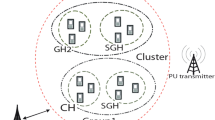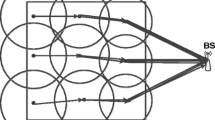Abstract
In Wireless Multimedia Sensor Network (WMSN), the time critical and delay sensitive applications like video, audio, image demands high bandwidth and transmission resources. The provision of Cognitive Radio (CR) can effectively utilize the available spectrum in the most appropriate way to provide high bandwidth in the Wireless Sensor Network (WSN) environment as Cognitive Radio sensor network (CRSN). The CR features are applicable in WMSN paradigm with required changes in transmission parameter for bandwidth hungry multimedia applications. In this paper, we propose an approach for setting up a cost-efficient and higher data rates communication in Wireless Multimedia Cognitive Radio Sensor Network (WMCRSN). The process analyses power allocation for sensor nodes by dynamic channel modelling and allocates power using multi-agent based Distributed Artificial Intelligence (DAI) in WMCRSN applications. The novelty in the approach lies in analyzing the real-time spectrum sensing outputs system for high data rate wireless multimedia applications. The DAI makes the process of power allocation in a smart way for having low latency based intra and inter cluster communication between sensor nodes. The performance parameters of the network, i.e. probability of detection and false alarm with the modelled error rates are presented. The mathematical analysis and simulation results justifies the feasibility and merits of the proposed method over conventional methods.





Similar content being viewed by others
References
Akyildiz IF, Lee W-Y, Vuran MC, Mohanty S (2006) Next generation/dynamic Spectrum access/cognitive radio wireless networks: a survey. Int J Comput Telecommun Netw 50:2127–2159
Almalkawi IT, Zapata MG, Al-Karaki JN, Morillo-Pozo J (2010) Wireless multimedia sensor networks: current trends and future directions. Sensors 10:6662–6717
Amjad M, Rehmani MH, Mao S (2018) Wireless multimedia cognitive radio networks: a comprehensive survey. IEEE Commun Surv Tut 20:1056–1103
Atapattu S, Tellambura C, Hai J (2011) Energy detection based cooperative Spectrum sensing in cognitive radio networks. IEEE Trans Wirel Commun 10:1232–1241
Cabric D, Mishra SM, Broderson RW (2004) Implementation issues in spectrum sensing for cognitive radios. IEEE Proc Signals Syst Comput:772–776
Charalambos D, Logothelis A (2000) Maximum likelihood parameter estimation from incomplete data via the sensitivity equations: the continuous time case. IEEE Trans Autom Control 45:24–25
Crohas (2008) Practical implementation of a cognitive radio system for dynamic Spectrum access. Master of Science in Electrical Engineering Thesis: Notre Dame, Indiana
Demetrio O, Restrepo D, Montoya A (2010) Artificial intelligence for wireless sensor networks enhancement. Smart Sensor Networks. ISBN: 978-953-307-261-6
Duong TQ, Hoang TM, Kundu C et al (2017) Optimal power allocation for multiuser secure communication in cooperative relaying networks. IEEE Wirel Commun Lett 5(5):516–519
Farhang-Boroujeny (2008) Filter bank spectrum sensing for cognitive radios. IEEE Trans Signal Process 56:1801–1811
Gardner WA (1988) Signal interception: a unifying theoretical framework for feature detection. IEEE Trans Commun 38:897–906
Goswami P et al (2016) Error analysis for high data rate applications using Welch's power spectral by cognitive radio users. International Conference on Information Communication and Embedded Systems (ICICES), Chennai (India), pp 1-7
Goswami P et al (2019) An energy efficient clustering using firefly and HML for optical wireless sensor network. Optik 182:181–185
Hao Q, Zhao R, Tongchen (2007) Interharmonics analysis based on interpolating windowed FFT algorithm. IEEE Trans Power Deliv 22:1064–1069
He P, Shi Y, Wang X, Li T (2017) Modeling wireless sensor networks radio frequency signal loss in corn environment. Multimed Tools Appl 76:19479–19490
Javaid S, Fahim H, Hamid Z, Hussain FB (2018) Traffic-aware congestion control (TACC) for wireless multimedia sensor networks. Multimed Tools Appl 77:4433–4452
Ma J, Li GY, Juang BH (2009) Signal processing in cognitive radio. Proc IEEE 97:805–823
Malla PP et al (2018) Design and analysis of direction of arrival using hybrid expectation-maximization and MUSIC for wireless communication. Optik - International Journal for Light and Electron Optics 170:48–55
Manz G, Pfletschinger S, Speidel J (2012) An efficient water-filling algorithm for multiple access OFDM. IEEE Conference 7803-7632:2012
Matlou OG, Abou-Mahfouz AM (2017) Utilising artificial intelligence in software defined wireless sensor network. Annual Conference of the IEEE Industrial Electronics Society. https://doi.org/10.1109/IECON.2017.8217065
Mitola J (1992) Software radios-survey, critical evaluation and future directions. IEEE Nat Telesyst Conf:19–20
Mukherjee A, Datta A (2016) Vector quantization based power allocation for non-ergodic cognitive radio systems. J Eng Sci Technol Rev 9:85–87
Mukherjee A et al (2014) Spectrum sensing for cognitive radio using quantized data fusion and hidden markov model. International Conference on Information Systems and Computer Networks (ISCON), Mathura, pp 133-137
Mukherjee A et al (2016) HML based smart positioning of fusion center for cooperative communication in cognitive radio networks. IEEE Commun Lett 20:4. https://doi.org/10.1109/LCOMM.2016.2602266
Mukherjee et al (2018) A novel approach of power allocation for secondary users in cognitive radio networks. Comput Electr Eng 75:301–308
Mukherjee A et al (2019) Distributed artificial intelligence based cluster head power allocation in cognitive radio sensor networks. IEEE Sens Lett:1–4. https://doi.org/10.1109/LSENS.2019.2933908
Mukherjee A, Goswami P, Yan Z, Yang L, Rodrigues JJPC (2019) ADAI and adaptive PSO-based resource allocation for wireless sensor networks. IEEE Access 7:131163–131171
Peng L, Song G, Jiankun H (2015) Energy-efficient cooperative communications for multimedia applications in multi-channel wireless networks. IEEE Trans Comput 64(6):1670–1679
Penna F, Pastrone C, Spirito MA, Garello R (2009) Energy detection spectrum sensing with discontinuous primary user signal. IEEE Proc. ICC
Qi Q, Minturn A, Yang Y (2012) An efficient water-filling algorithm for power allocation in OFDM-based cognitive radio systems. IEEE International Conference on Systems and Informatics:2069–2073
Sahai A, Hoven N, Tandra R (2004) Some fundamental limits on cognitive radio. In: Proc. Allerton Conference on Communications, Control, and Computing
Samant T et al (2016) LEACH–V: a solution for intra-cluster cooperative communication in wireless sensor network. Indian J Sci Technol:9–48
Solomon OM (1994) The use of DFT windows in signal-to-noise ratio and harmonics distortion computations. IEEE Trans Instrum Meas 43:194–199
Wu (1983) On the convergence properties of the EM algorithm. Ann Stat 11:95–103
Yucek T, Arslan H (2009) A survey of spectrum sensing algorithms for cognitive radio applications. IEEE Commun SurvTut 11
Zhu J, Xu Z, Wang F, Huang B, Zhang B (2008) Double threshold energy detection of cooperative spectrum sensing in cognitive radio. IEEE Proc CrownCom:1–5
Zhu J, Jiang D, Yuan Y-h, Li F-w (2016) An evolutionary game theory-based channel access mechanism for wireless multimedia sensor network with rate-adaptive applications. Multimed Tools Appl 75:14329–14349
Ziwei Y et al (2019) Energy-efficient node positioning in optical wireless sensor networks. Optik 178:461–466
Author information
Authors and Affiliations
Corresponding author
Additional information
Publisher’s note
Springer Nature remains neutral with regard to jurisdictional claims in published maps and institutional affiliations.
Rights and permissions
About this article
Cite this article
Mukherjee, A., Goswami, P. & Yang, L. DAI based wireless sensor network for multimedia applications. Multimed Tools Appl 80, 16619–16633 (2021). https://doi.org/10.1007/s11042-020-08909-3
Received:
Revised:
Accepted:
Published:
Issue Date:
DOI: https://doi.org/10.1007/s11042-020-08909-3




